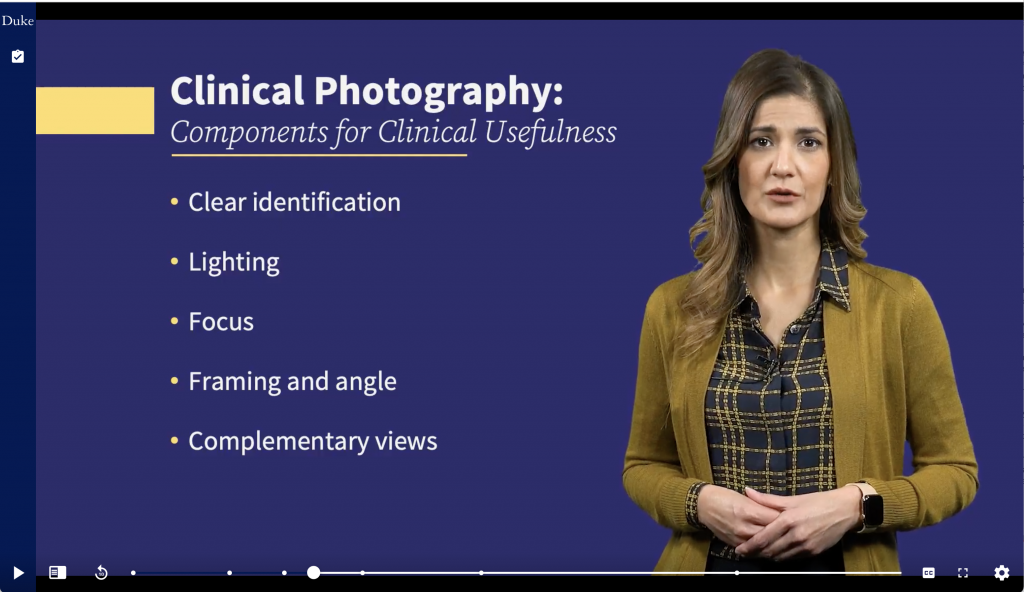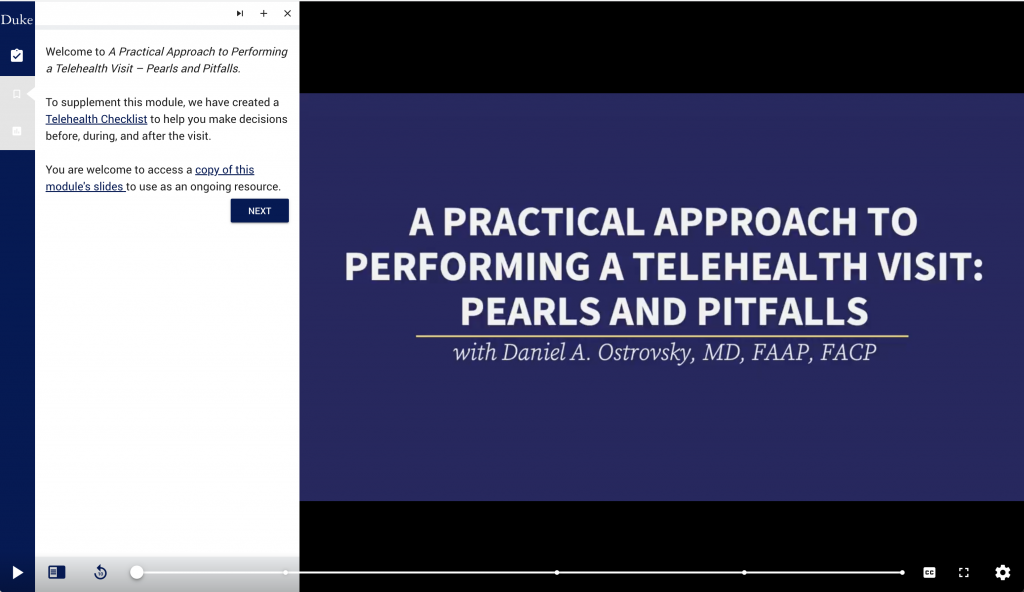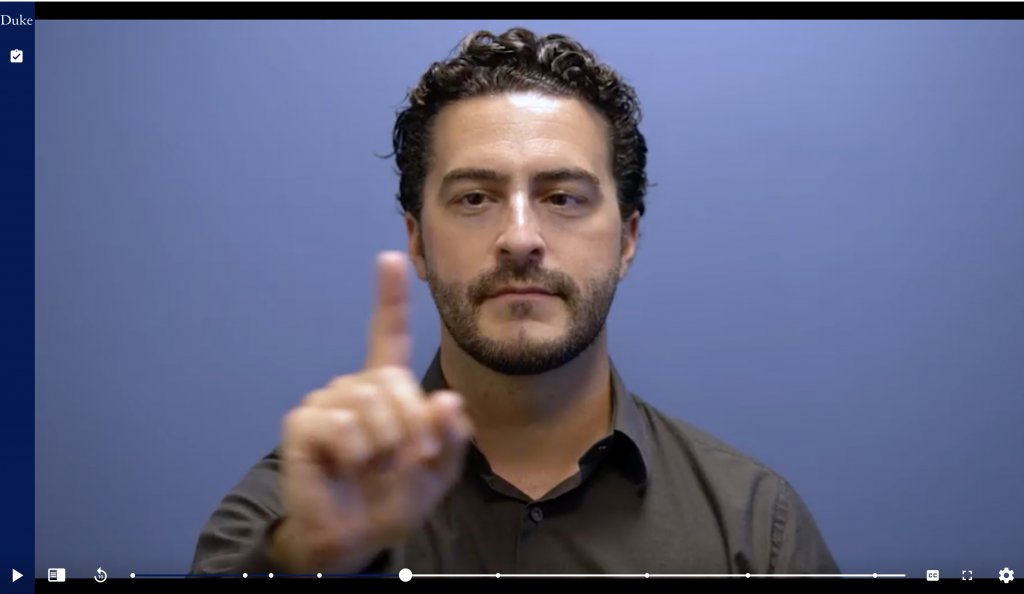During Spring 2021 Duke Learning Innovation opened up applications for its Carry the Innovation Forward program. The idea behind this program was to invest in strong teaching innovations that had arisen due to the onset of the COVID-19 pandemic, even as emergency remote teaching was winding down at Duke University. Duke faculty submitted applications and, if their projects were selected, received support from Learning Innovation during the 2021-22 year to reach their goals.
Investing in Telehealth

Just as instructors with no previous experience in online learning needed to quickly adapt their courses during the onset of the pandemic, many health professionals with no previous telehealth experience were asked to see patients remotely. Telehealth increases access to healthcare and, in some cases, even allows medical professions to learn information they would not have from an in-person visit. This is not just a substitute for traditional care, but an innovation that Daniel Ostrovsky, MD, Associate Professor of Medicine and Pediatrics and Kathleen Waite, MD — Associate Professor of Medicine — saw worthy of Duke’s investment.

Specifically, Ostrovsky and Waite sought to create material for interprofessional health education students — including medical, physical therapy, occupational therapy, physician assistant, and nursing students — that would give them the skills to feel comfortable with telehealth both as individual providers and as part of an interdisciplinary team. Unlike other telehealth educational materials, which teach telehealth by modeling simulated encounters, Ostrovsky and Waite adopted a logistical approach, incorporating practical tips, such as camera position or lighting, to ensure that practitioners had the tools they needed to provide the best experience for the patient.
“Telehealth is a relatively new phenomenon for mainstream clinicians and the pandemic makes it plain that there is a gap in formal education and curricula that teach the clinical essentials of telehealth to healthcare professionals,” Ostrovsky said.
“Recognizing the packed curriculum of health professions students, we wanted to create materials that could be easily integrated into existing interprofessional health education courses by using a virtual, asynchronous, and modular format on an accessible platform,” he said.
To accomplish this goal, Ostrovsky and Waite worked with a Learning Innovation design team, as well as medical professionals across Duke, to create a series of nine virtual modules called Duke Interprofessional Health Education Series: Clinical Essentials of Telehealth.
The introductory module — “A Practical Approach to Performing a Telehealth Visit: Pearls and Pitfalls” — explains best practices that can make a telehealth visit run smoothly for both the patient and provider. The following eight modules cover specialty-specific telehealth practices (and note when a telehealth visit might not be appropriate for treatment) for areas such as general assessment, head and neck, cardiopulmonary, musculoskeletal, neurology, and dermatology.

Using Playposit to Create Interactive Learning Experiences
To create engaging educational materials, Ostrovsky and Waite selected a tool called Playposit to create interactive videos. Playposit allows users to layer interactions over videos, including multiple choice quiz questions, reflective pauses, and web embeds (for example, to a survey designed in Qualtrics).

But the design process for creating these modules from scratch was far more detailed than simply layering interactions onto a pre-made video — Playposit was used to implement the vision for the modules, rather than determining all design choices.
The design process for each module required a series of planned steps:
- Identifying the target audience;
- Determining measurable and specific learning outcomes for the module;
- Connecting with disciplinary-specific experts and conducting research to determine the specific content of the module, ensuring it aligned with proposed outcomes;
- Writing a script, with the hope of being straight-forward and comprehensive;
- Planning with Media Producer Michael Blair to shoot both the lecture and demonstration content;
- Creating supplemental learning materials alongside Learning Innovation (slides, checklists, etc.) that would enhance the learning experience;
- Writing quiz questions that cover the module’s learning outcomes and determining where in the video it would make sense to “check-in” with learners;
- Developing a survey that would measure the effectiveness of the module;
- Building the modules in Playposit, once the final video had been produced and the other content finalized; and
- Quality-Assurance testing the Playposit build, to make sure the learner experience would run smoothly

After all of the modules were completed, they were put together on a Sakai site for Duke learners and a WordPress site for learners external to Duke. Through the 2021-2022 development of these modules, Ostrovsky and Waite came to value teamwork, particularly when developing project milestones.
“Keeping on track of the many moving parts of a multimedia project takes a village!” Ostrovsky said. “Having clear goals and clear delegation of duties helps to keep everything moving in forward motion.”
Looking to the Future
Ostrovsky and Waite not only want to provide resources to potential telehealth providers but also want to collect research data (in particular, from learners and course directors) from the modules to see if the series is a success.
Success is, in Ostrovsky’s words, “if our modules are providing the skills we designed them to teach and whether the delivery mechanism meets our goals of easy access and integration.”
This data collection will not stay internal to the telehealth team — Ostrovsky and Waite hope to publish on their findings and share their materials.
And they already have plans to expand their range of materials and audience beyond Duke to increase the project’s impact.
“Although we started this project with undergraduate health professional students in mind,” Waite said, “As we worked on this project we understood that there may also be application to learnings in residency training as well as providers in practice.”
Learn More
If you’re interested in enrolling in the Duke Interprofessional Health Education Series: Clinical Essentials of Telehealth, you can join the Sakai site if you’re affiliated with Duke. Or, if you’re external to Duke, you can enroll in the series through its public-facing site.
Would you like to learn more about Playposit and if it’s the right tool for your learning experience? You can contact Learning Innovation at learninginnovation@duke.edu.
